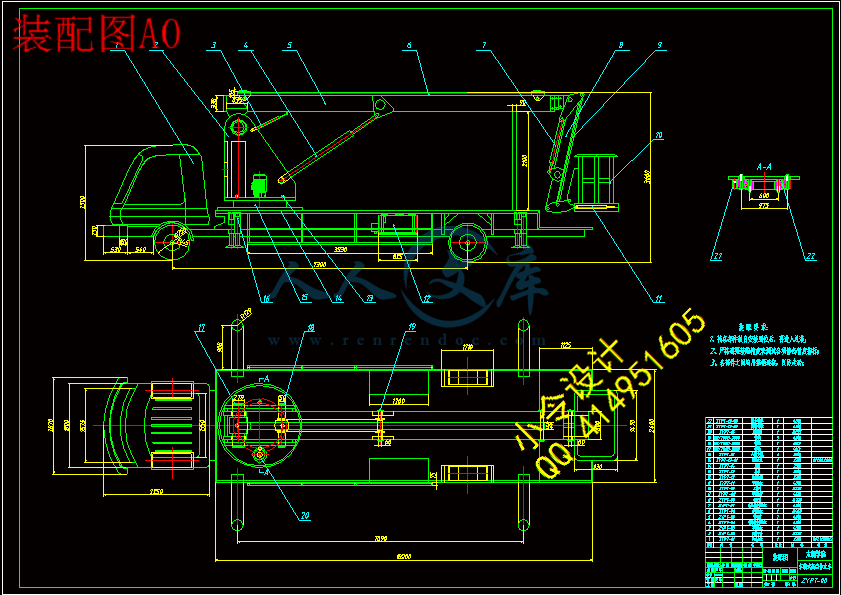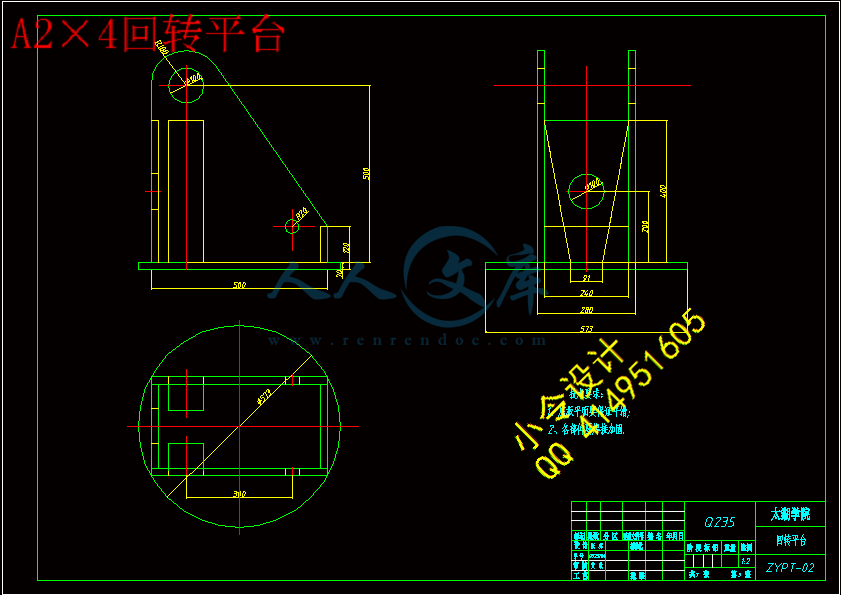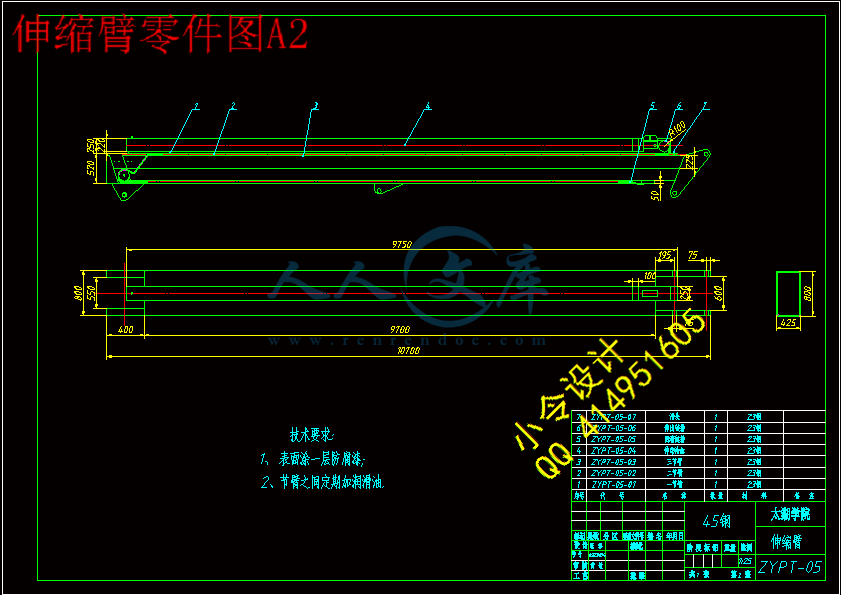【温馨提示】 购买原稿文件请充值后自助下载。
[全部文件] 那张截图中的文件为本资料所有内容,下载后即可获得。
预览截图请勿抄袭,原稿文件完整清晰,无水印,可编辑。
有疑问可以咨询QQ:414951605或1304139763
摘 要
本课题首先对国内外高空作业车的发展进行了概括,提出了发展中的不足,简要介绍了高空作业车的组成,然后对目前国内生产技术不完善的混合臂和伸缩臂式高空作业车的关键结构进行了设计,同时对工作斗调平技术和液压系统等关键技术进行了研究分析。重点研究了伸缩臂的结构、运动特点,并对其进行了强度校核。根据高空作业车安全性要求高,工作幅度大,结构复杂等特点,提出了工作臂、副车架以及工作斗调平机构的研究设计方法。该课题以混合臂式高空作业车为研究对象,详细阐述了伸缩臂的结构设计、变形研究;副车架结构设计、工作稳定性分析;高空作业车的工作斗调平系统的研究分析;液压系统的设计计算。课题采用积分法对伸缩臂结构进行应力分析、变形分析。最后,对研究分析结果进行了试验和验证,将试验结果和理论分析结果进行了对比,通过对比分析进一步验证了本文提出的设计方法,对于同类型高空作业车研究计算,具有一定的参考价值。
关键词 :高空作业车;结构设计;调平系统研究;液压缸
Abstract
This paper arranged as follows. The first part is the summary of the development of aerial working platform at home and abroad, and put forward some shortages during the development. There is a brief introduction of the component parts of the aerial working platform. This paper introduces a new design proposal of the domestic production technology of mixing arm and telescopic arm aerial working platform. Meanwhile, the analysis can also be seen in the working bucket leveling, hydraulic systems and other key technology. This paper mainly focuses on the telescopic structure, movement characteristics, and its strength check. According to the special requirements of aerial vehicles because of the high security, large in range and the complicated structure, the special design was used in the working arm, subframe and bucket leveling institutions. The subject is based on the study of mixing arm of aerial working platform. The subject describes the structural design of the telescopic boom in detail, and analysis the design of subframe structure design and the job stability. The aerial working platform bucket leveling system analysis and hydraulic syetem design are also mentioned here.the subject adopts integration method on the telescopic structure stress analysis and deformation analysis. The results of research and analysis are also compared in this part. The new design method is created through comparative analysis. And it is an useful guideline for the same type of aerial working platform.
Key words: Aerial working platform; Structure design; The research of leveling system; The hydraulic cylinder
目 录
摘 要III
AbstractIV
目 录V
1 绪论1
1.1本课题的研究内容和意义1
1.1.1 课题研究背景1
1.1.2 课题研究的意义1
1.2 高空作业机械的国内外发展概况1
1.2.1 高空作业机械的国外发展状况1
1.2.2 高空作业机械的国内发展状况2
1.3 高空作业车的组成2
1.3.1 专用底盘2
1.3.2 工作臂架3
1.3.3 三维全旋机构3
1.3.4 电气与液压系统3
1.3.5 安全装置3
1. 4 课题研究的内容4
2伸缩臂结构分析5
2.1 伸缩臂的结构5
2.2 工况分析6
2.3 伸缩臂强度计算分析6
2.3.1 危险工况 1 计算7
2.3.2 危险工况 2 计算7
2.4 伸缩臂变形计算8
2.4.1 力学模型的建立8
2.4.2 弹性位移的计算9
2.4.3 计算结果12
2.5 伸缩臂强度校核12
2.5.1 计算基本臂臂的截面尺寸14
2.5.2对下臂进行正应力校核15
2.6 本章小结16
3 副车架结构及分析17
3.1 副车架结构17
3.2 支腿反力的计算17
3.3 转台回转系统21
3.4 本章小结22
4 工作斗调平机构的研究23
4.1 工作斗调平结构模型23
4.2调平机构液压系统25
4.3 本章小结26
5液压油缸的设计计算27
5.1 伸缩变幅油缸的结构27
5.2 伸缩变幅油缸的设计计算27
5.2.1 确定液压缸类型和安装方式27
5.2.2 确定液压缸的主要性能参数和主要尺寸27
5.3 本章小结31
6 结论与展望32
6.1 结论32
6.2 展望32
致 谢33
参考文献33
附 录33
1 绪论
1.1本课题的研究内容和意义
1.1.1 课题研究背景
现如今我国经济的飞速发展以及政府对基础设施建设的力度逐渐增大,高空作业平台的需求量不断增加,市场前景非常广阔。然而由于我国对于高空作业平台的研究开发起步较晚,对其核心技术掌握的不足以及加工工艺的落后等方面的原因,使得我国高空作业产品的使用功能、安全性等方面得不到充分的质量保证。通过对目前高空作业产品市场的发展趋势和广泛的市场研究,发现国内产品具有类型单一、设计粗糙等缺陷,无法满足很多特殊施工环境的要求[l],因此我国高空作业设备大多依赖进口。虽然国外产品功能完善、性能比较优秀,但是由于价格太高,对很多建设公司或者施工方来说成本占用比例过大,使得利润空间降低。因此,研发生产属于我国自主品牌的高性能的高空作业平台有着极其重要的经济价值和战略意义。
高空作业平台是用来运送工作人员和工作装备到指定高度进行作业的一种大型工程机械设备,并广泛用于电力、路灯、市政、园林、通信、机场、造(修)船、交通、广告、摄影等高空作业领域。国家标准GB3608.93《高处作业分级》规定:VL在坠落高度基准面2m以上(含2m)有可能坠落的高处进行作业,都称为高处作业。"因此为保障工人在高处作业的安全性,出现了越来越多的高空作业设备,然而随着科技的发展和人们对使用要求的增加,传统的高空作业设备已经无法满足人们的需求,专用高空作业平台技术在最近几十年来得以快速发展。
1.1.2 课题研究的意义
随着社会的进步和发展,人们对于产品的人性化要求越来越高,因此在产品结构设计的过程中应坚持人性化思想[2],以人机工程学原理为指导充分分析研究产品各方面因素,提出相应的设计方案。本课题在充分研究产品性能的基础上,对高空作业平台的功能模块进行了充分的结构分析,并根据其各方面的特殊性提出了相应的设计要求,指导其结构设计,因此课题研究的意义主要体现在以下几个方面:
(1)通过本课题的研究,掌握混合臂高空作业车金属结构件的设计理论和分析方法,了解高空作业车结构件的工作规律,从而达到减轻自重、优化结构、提高可靠性的目的,为研制系列伸缩臂、混合臂高空作业车奠定良好的基础。
(2)对车载式高空作业平台进行模块划分,将其分为工作平台、操作系统、运动系统和支持系统几个部分进行分别研究,对每一部分进行充分的结构分析,结合产品的相关标准和设计原则,对其结构设计进行指导。在课题的研究过程中结合产品的使用功能,通过计算机建模,在保证实现基本功能的基础上,总结相应的外观设计理论,以指导后续系列产品的结构设计,同时对于其它机械产品的外观设计研究具有一定的理论指导意义。
1.2 高空作业机械的国内外发展概况
1.2.1 高空作业机械的国外发展状况
高空作业车发展起步较早的欧美等发达国家和地区,从20世纪20年代就开始研制,发展历史久远,生产技术也很成熟,具有生产技术水平高、作业车的作业高度大、规格齐全、结构型式丰富、功能多样等优点。总体来看,技术和市场均已很成熟,产品能够进行高空作业、抢险、救援、消防等复杂工作,作业平台的最大载荷可达500kg,最大作业高度已经超过100m,这是我国目前无法设计达到的高度,同时具有各种安全保护措施,很好的保障了工人的安全。大型产品特点是科技含量高、研制与生产周期较长、投资大、市场容量有限,但市场竞争相对较少,产品的利润相对较高。如美国Genie公司、JLG公司和法国HAULOTTE公司在高空作业平台产品都形成了系列化,与此同时,产品更新换代的周期明显缩短。这大大提高了企业在国际市场中的竞争能力和企业的抗风险能力。
1.2.2 高空作业机械的国内发展状况
我国产品在质量和性能上与国外优秀产品虽然存在一定的差距,但是随着科技的不断发展,产品的功能和性能已经逐渐趋于同质化[3],因此必须通过对我国高空作业机械产品与国外先进企业产品进行分析和比较,找出发展问题的之所在,并提出相应的解决方案。我国高空作业平台的使用范围与国外相比来说还比较窄,使用较多的有路灯、交通、园林等部门,而在有发展前途的电力、电信及有线电视系统使用较少,市场远远没有挖掘和培育出来[3]。目前市场上的主要产品仍然是体积教大,对作业场地要求较高的拖车式或车载式高空作业车,而我国市场上的车载式高空作业车多为价格昂贵的国外进口产品或中外合资企业的产品,我国本土研发的设备极少,因此我们开发研制出拥有自主产权的高性能车载式高空作业平台具有很强的发展战略意义。
我们应提高工程设计效率和品质,节约设计成本,缩短设计周期[4-5]。而传统设计在设计一个工程结构的时候,首先要采用类比方法确定设计方案的初稿,然后对其结构进行分析,画出图纸,然后对重要部件进行强度的校核,并根据校核的结果重新修改设计方案,一般往往要进行多次分析校核和调整才能得到优秀的设计方案。这种设计方法的设计周期长、代价高、效率低,且所得到的方案多数不是最优方案[6-7]。只有加大行业技术创新力度,开发先进的高空作业机械,满足用户的差别化和个性化需求,为用户精细化服务,才能提高中国产品的市场竞争能力。
在我国实际工作过程中,人们对于安全性和劳动条件提出了更高的要求,尤其是在高空作业中,原始的脚手架、吊篮等安全系数较低的工作方式将会越来越少,而对于高空作业机械的需求必将越来越多[8]。另一方面,中国造船业逐渐成为世界第一,对于大型车载式高空作业平台的需求急剧增加。据不完全统计,仅中国造船行业在2009年约需六七百台高空作业平台[9],这一市场之前基本都被国外品牌占据。因此,研发生产属于我国自主品牌的高性能的高空作业平台有着极其重要的经济价值。虽然国内产品近些年来发展较快,但从整体上看,无论是技术上还是应用上都落后于国外同类产品,与国外先进产品相比还有较大的差距。
1.3 高空作业车的组成
高空作业车正常进行作业,需要由专用底盘、工作臂架、三维全旋机构、液压系统、电气系统和安全装置等部分组成,性能如下。
1.3.1 专用底盘
专用底盘。由发动机、车架、行走机构、转向机构等组成。考虑到工作可靠性、噪声、排放等方面综合要求,优选康明斯B3.3~C60型工程机械专用柴油发动机,该发动机为直列4缸水冷、自然吸气发动机,带全程调速器,运行平稳,具有热效率高、比油耗低、排放污染少等特点。由于台车行驶速度低,综合考虑作业安全性和经济性,车架采用刚性连接式,不设悬架机构,轮胎选用高负荷实心橡胶轮胎。
1.3.2 工作臂架
工作装置由回转台、工作臂架、伸缩软链等组成。回转台通过回转支承安装在车架上,由回转机构驱动,可实现360°全回转。回转机构包括行星减速机、常闭式制动器、液压马达等构成,与回转支承采用外啮合传动方式。
1.3.3 三维全旋机构
三维全旋机构设备或系统的安装位置一般由标高和方向2个参数确定。由于要求被举升物体在空间相互垂直的3个方向可以进行独立旋转,使物体可以获得任意安装角度,因此设计了三维全旋机构,即在水平和竖直方向设置±90°。旋转机构俯仰方向转角可以通过臂架变幅进行,微调由调平油缸实现,不再设单独机构,从而减少机构设置。
1.3.4 电气与液压系统
液压系统采用1台变量柱塞泵和1台定量齿轮泵供油,由发动机驱动。变量泵为行走、转台回转、臂架变幅和臂架伸缩供油,齿轮泵为行走转向机构、工作装置摆动、工作装置翻转、工作装置夹紧和调平机构微调供油。由变量泵供油的动作采用比例阀进行控制,以便精确进行速度调节,其它动作由于速度低、流量小,直接采用电磁换向阀进行控制。液压系统内设有安全溢流阀、液压锁等安全装置。






 川公网安备: 51019002004831号
川公网安备: 51019002004831号